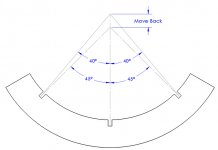I've done everything Festool told me to do to get my new Kapex calibrated, but no luck. I get the 90 spot on, but then the 45's are out of whack. The supplemental manual has instructions for the 90 calibration, but not the 45's. So I called the company several times to ensure I'm doing what they told me to do. Here's what the said: The company told me to adjust the miters, move the arm to the right, to loosen the middle and right screws, unlock the miter arm, then pivot the scale in or out (with the left screw still tightened. I then go to the left and do everything in reverse. So I get the 45's dialed in, then go back to the 90 and it is out of whack. Then back to get the 90 dialed in again, then right 45, then left 45, then check the 90. The 90 always is out when I go back to it. In six hours of fiddling, I must have repeated this cycle 40 times. Went through a quarter sheet of mdf doing the 4 cut method for 90s and about 10 lineal feet of 2 inch stock doing the 45s. I am so frustrated I'm ready to throw this thing in the ocean. Anyone have a suggestion?
BTW (editorial comment): I have found the Festool customer service to be somewhat lacking. It is impossible to get a live person to talk to for this kind of help. You have to leave a message and then they call you back about 2 hours later. Meanwhile. For this kind of money one spends on Festool, you'd think they could hire a few more people so you don't get sent to voice mail every time.
Frustrated in California.
BTW (editorial comment): I have found the Festool customer service to be somewhat lacking. It is impossible to get a live person to talk to for this kind of help. You have to leave a message and then they call you back about 2 hours later. Meanwhile. For this kind of money one spends on Festool, you'd think they could hire a few more people so you don't get sent to voice mail every time.
Frustrated in California.

